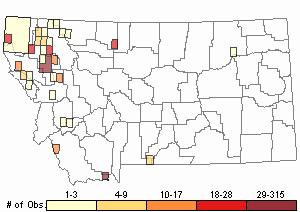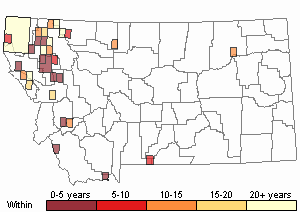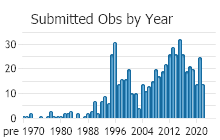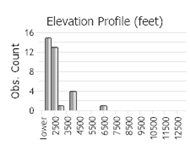View in other NatureServe Network Field Guides
NatureServe
Montana
Utah
Wyoming
Idaho
Wisconsin
British Columbia
South Carolina
Yukon
California
New York
Lake Trout - Salvelinus namaycush
State Rank Reason (see State Rank above)
Species is native to a few lakes and one drainage within the state. Threats are poorly described and occupancy at native sites is likely stable.
General Description
The Lake Trout is a char of the same genus as Bull Trout and Brook Trout. Lake Trout are native in the St. Mary and Missouri River drainages and have been introduced to a few other scattered mountain lakes, Flathead Lake, and Fort Peck Reservoir. Lake Trout are a major game fish in much of Canada and were at one time a staple of the Great Lakes fishery. In Montana, the Lake Trout of Flathead Lake have achieved trophy status, growing to 42 pounds. Lake Trout inhabit very deep, cold lakes, living in water up to 200 feet deep. They spawn in the fall on the rocky substrate of the shoreline. They scatter or broadcast their spawn, a rarity in the trout group. Small Lake Trout feed on plankton and aquatic invertebrates but fish over 2 to 3 pounds eat a fish diet. Lake Trout are a highly-prized food fish in Canada and are catching on as a game fish in Montana with the advent of downriggers, electronic fish finders, and other specialized techniques.
For a comprehensive review of the ecology, conservation status, threats, and management of this and other Montana fish species of concern, please see
Montana Chapter of the American Fisheries Society Species of Concern Status Reviews.Diagnostic Characteristics
Lake trout are typically trout-like in shape. Like other chars, lake trout have light spotting on a dark background that can range from light green to almost black. A narrow, sometimes indistinct, white anterior border is present on the pectoral, pelvic and anal fins. Lake trout can be distinguished from other chars by their deeply forked tail
Species Range
Range Comments
Lake trout are native to northern North America, with their historic range determined primarily by the extent and dynamics of the Pleistocene glaciations. The lake trout's native range includes portions of all of the Canadian provinces except Newfoundland and Prince Edward Island, and the states of Alaska, Maine, Illinois, Indiana, Massachusetts, Michigan, Minnesota, Montana, New Hampshire, New York, Ohio, Pennsylvania, Vermont and Wisconsin. Native Montana Populations are found within the Big Hole and Red Rock Drainages and the Hudson Bay Drainages of Glacier Park.
Observations in Montana Natural Heritage Program Database
Number of Observations: 602
(Click on the following maps and charts to see full sized version)
Map Help and Descriptions
Relative Density

Recency



 (Observations spanning multiple months or years are excluded from time charts)
(Observations spanning multiple months or years are excluded from time charts)
Habitat
Deep, cold lakes and reservoirs (Montana Department of Fish, Wildlife, and Parks 2003). Deep cold water lakes and reservoir with some rocky bottom and on abundance of forage fish. Spawns over rocky shoal areas in lakes in depths from 10 to 120 feet.
Food Habits
Young lake trout feed on plankton and aquatic invertebrates. Diet is largely other fish after reaching 2-3 lbs. in weight.
Ecology
Whereas lake trout can be found in cold rivers and shallow lakes in the northern portion of its range (Scott and Crossman 1973), in Montana native lake trout inhabit a few relatively deep, cold lakes remaining from the Pleistocene glaciations.
Reproductive Characteristics
Broadcasts spawn Oct-Nov. Eggs hatch in following March or April when water temperatures reach 34-38 degrees F. Fry soon move into deep water. No parental care.
Management
The genetic uniqueness and significance of Montana's native lake trout populations to the post-glacial distribution of the species mandate that these remnant native populations be conserved.
Stewardship Responsibility
Threats or Limiting Factors
Lake trout populations have been decimated by over-harvest, habitat loss, pollution, and introductions of non-native fish species, especially sea lampreys (Petromyzon marinus) into the Great Lakes. Efforts to re-establish native lake trout populations have generally not met management goals.
References
- Literature Cited AboveLegend:
 View Online Publication
View Online Publication Lee, D.S., C.R. Gilbert, C.H. Hocutt, R.E. Jenkins, D. E. McAllister, J. R. Stauffer, Jr. 1980. Atlas of North American freshwater fishes. North Carolina State Musuem of Natural History. 867 p.
Lee, D.S., C.R. Gilbert, C.H. Hocutt, R.E. Jenkins, D. E. McAllister, J. R. Stauffer, Jr. 1980. Atlas of North American freshwater fishes. North Carolina State Musuem of Natural History. 867 p. Scott, W.B. and E.J. Crossman. 1973. Rainbow trout, Kamloops trout, Steelhead trout Salmo gairdneri Richardson. pp. 184-191. In: Freshwater fishes of Canada. Ottawa, Canada: Fisheries Research Board of Canada, Bulletin 184. 966 p.
Scott, W.B. and E.J. Crossman. 1973. Rainbow trout, Kamloops trout, Steelhead trout Salmo gairdneri Richardson. pp. 184-191. In: Freshwater fishes of Canada. Ottawa, Canada: Fisheries Research Board of Canada, Bulletin 184. 966 p.
- Additional ReferencesLegend:
 View Online Publication
View Online Publication
Do you know of a citation we're missing? Alowaifeer, A.M. 2019. The application of mass spectrometry in environmental chemistry: investigating biological cycling of arsenic, mercury and glycine betaine in aquatic ecosystems. Ph.D. Dissertation. Bozeman, MT: Montana State University. 167 p.
Alowaifeer, A.M. 2019. The application of mass spectrometry in environmental chemistry: investigating biological cycling of arsenic, mercury and glycine betaine in aquatic ecosystems. Ph.D. Dissertation. Bozeman, MT: Montana State University. 167 p. Cavender, T.M. 1980. Systematics of Salvelinus from the North Pacific Basin. pp. 295-322 In: E.K. Balon (ed.) Salmonid Fishes of the Genus Salvelinus Vol. 1. The Hague, Netherlands: Dr. W. Junk bv Publishers. 936 p.
Cavender, T.M. 1980. Systematics of Salvelinus from the North Pacific Basin. pp. 295-322 In: E.K. Balon (ed.) Salmonid Fishes of the Genus Salvelinus Vol. 1. The Hague, Netherlands: Dr. W. Junk bv Publishers. 936 p. Cavender, T.M. 1984. Cytotaxonomy of North American Salvelinus. pp. 431-445 In: Johnson, L. And B.L. Burns (Eds). Biology of the Arctic Char: Proc. of the International Symposium on Arctic char. Winnipeg, Manitoba. May 1981.
Cavender, T.M. 1984. Cytotaxonomy of North American Salvelinus. pp. 431-445 In: Johnson, L. And B.L. Burns (Eds). Biology of the Arctic Char: Proc. of the International Symposium on Arctic char. Winnipeg, Manitoba. May 1981. Cox, B.S. 2010. Assessment of an invasive Lake Trout population in Swan Lake, Montana. M.Sc. Thesis. Bozeman, Montana: Montana State University. 79 p.
Cox, B.S. 2010. Assessment of an invasive Lake Trout population in Swan Lake, Montana. M.Sc. Thesis. Bozeman, Montana: Montana State University. 79 p. Dux, A.M. 2005. Distribution and population characteristics of lake trout in Lake McDonald, Glacier National Park: Implications for suppression. M.Sc. Thesis. Bozeman, MT: Montana State University. 87 p.
Dux, A.M. 2005. Distribution and population characteristics of lake trout in Lake McDonald, Glacier National Park: Implications for suppression. M.Sc. Thesis. Bozeman, MT: Montana State University. 87 p. Fausch, K.D. 1992. Life as a trout, predator. Trout Magazine Winter 1992. pp. 63-74
Fausch, K.D. 1992. Life as a trout, predator. Trout Magazine Winter 1992. pp. 63-74 Fredenberg, C.R. 2014. Efficacy of suppressing non-native Lake Trout in an isolated backcountry lake in Glacier National Park. M.Sc. Thesis. Bozeman, MT: Montana State University. 87 p.
Fredenberg, C.R. 2014. Efficacy of suppressing non-native Lake Trout in an isolated backcountry lake in Glacier National Park. M.Sc. Thesis. Bozeman, MT: Montana State University. 87 p. Holton, G.D. 1981. Identification of Montana's most common game and sport fishes. Montana Outdoors May/June reprint. 8 p.
Holton, G.D. 1981. Identification of Montana's most common game and sport fishes. Montana Outdoors May/June reprint. 8 p. Joslin, Gayle, and Heidi B. Youmans. 1999. Effects of recreation on Rocky Mountain wildlife: a review for Montana. [Montana]: Montana Chapter of the Wildlife Society.
Joslin, Gayle, and Heidi B. Youmans. 1999. Effects of recreation on Rocky Mountain wildlife: a review for Montana. [Montana]: Montana Chapter of the Wildlife Society. Koel, T.M., L.M. Tronstad, J.L. Arnold, K.A. Gunter, D.W. Smith, J.M. Syslo, and P.J. White. 2019. Predatory fish invasion induces within and across ecosystem effects in Yellowstone National Park. Science Advances 5:eaav1139.
Koel, T.M., L.M. Tronstad, J.L. Arnold, K.A. Gunter, D.W. Smith, J.M. Syslo, and P.J. White. 2019. Predatory fish invasion induces within and across ecosystem effects in Yellowstone National Park. Science Advances 5:eaav1139. Marcus, M.D., M.K. Young, L.E. Noel and B.A. Mullan. 1990. Salmonid-habitat relationships in the western United States: a review and indexed bibliography. USFS General Tech. Report RM-188. 84 p.
Marcus, M.D., M.K. Young, L.E. Noel and B.A. Mullan. 1990. Salmonid-habitat relationships in the western United States: a review and indexed bibliography. USFS General Tech. Report RM-188. 84 p. Mullins, M.S. 1991. Biology and predator use of cisco (Coregonus artedi) in Fort Peck Reservoir, Montana. M.Sc. Thesis. Bozeman, MT: Montana State University. 68 p.
Mullins, M.S. 1991. Biology and predator use of cisco (Coregonus artedi) in Fort Peck Reservoir, Montana. M.Sc. Thesis. Bozeman, MT: Montana State University. 68 p. Nelson, P.H. 1953. Life history and management of the American Grayling (Thymallus signifer tricolor) in Montana. M.Sc. Thesis. Bozeman, MT: Montana State University. 45 p.
Nelson, P.H. 1953. Life history and management of the American Grayling (Thymallus signifer tricolor) in Montana. M.Sc. Thesis. Bozeman, MT: Montana State University. 45 p. Owens, R.W., and R.A. Bergstedt. 1994. Response of slimy sculpins to predation by juvenile lake trout in southern Lake Ontario. Transactions - American Fisheries Society. 123(1): 28-36.
Owens, R.W., and R.A. Bergstedt. 1994. Response of slimy sculpins to predation by juvenile lake trout in southern Lake Ontario. Transactions - American Fisheries Society. 123(1): 28-36. Poole, A.S. 2019. Evaluation of embryo suppression methods for nonnative Lake Trout in Yellowstone Lake, Yellowstone National Park, Wyoming, USA. M.Sc. Thesis. Bozeman, MT: Montana State University. 108 p.
Poole, A.S. 2019. Evaluation of embryo suppression methods for nonnative Lake Trout in Yellowstone Lake, Yellowstone National Park, Wyoming, USA. M.Sc. Thesis. Bozeman, MT: Montana State University. 108 p. Poore, M.D. 1973. The fishery resource of Mystic Lake, Montana. M.Sc. Thesis. Bozeman, MT: Montana State University. 30 p.
Poore, M.D. 1973. The fishery resource of Mystic Lake, Montana. M.Sc. Thesis. Bozeman, MT: Montana State University. 30 p. Puchany, Andriana Rachel. 2021. Success of Westslope Cutthroat Trout and Arctic Grayling conservation translocations in Yellowstone National Park, Montana and Wyoming, USA . M.S. Thesis. Montana State University, Bozeman, MT. 125 pp.
Puchany, Andriana Rachel. 2021. Success of Westslope Cutthroat Trout and Arctic Grayling conservation translocations in Yellowstone National Park, Montana and Wyoming, USA . M.S. Thesis. Montana State University, Bozeman, MT. 125 pp. Rahrer, J.F. 1963. Age and growth of four species of fish, Flathead Lake, Montana. M.Sc. Thesis. Bozeman, MT: Montana State University. 16 p.
Rahrer, J.F. 1963. Age and growth of four species of fish, Flathead Lake, Montana. M.Sc. Thesis. Bozeman, MT: Montana State University. 16 p. Schultz, L.P. 1941. Fishes of Glacier National Park, Montana. USDI Conservation Bulletin No. 22. Washington D.C.: US Government Printing Office. 42 p.
Schultz, L.P. 1941. Fishes of Glacier National Park, Montana. USDI Conservation Bulletin No. 22. Washington D.C.: US Government Printing Office. 42 p. Siemiantkowski, Michael James. 2021. Combination of acoustic telemetry and side-scan sonar provides insight for Lake Trout (Salvelinus namaycush) suppression in a submontane lake. M.S. Thesis. Montana State University, Bozeman, MT. 54 pp.
Siemiantkowski, Michael James. 2021. Combination of acoustic telemetry and side-scan sonar provides insight for Lake Trout (Salvelinus namaycush) suppression in a submontane lake. M.S. Thesis. Montana State University, Bozeman, MT. 54 pp. Staples, D.F. 2006. Viable population monitoring: risk-based population monitoring for threatened and endangered species with application to bull trout, Salvelinus confluentus. Ph.D. Dissertation. Bozeman, MT: Montana State University. 127 p.
Staples, D.F. 2006. Viable population monitoring: risk-based population monitoring for threatened and endangered species with application to bull trout, Salvelinus confluentus. Ph.D. Dissertation. Bozeman, MT: Montana State University. 127 p. Sylvester, R. and B. Marotz. 2006. Evaluation of the Biological Effects of the Northwest Power Conservation Council's Mainstem Amendment on the Fisheries Upstream and Downstream of Hungry Horse and Libby Dams, Montana. Montana Fish, Wildlife, and Parks Annual Report prepared for U.S. Department of EnergyBonneville Power Administration. Bonneville Power Administration Project No. 2006-008-00 Contract No. 28350. 124 p.Contract No. 28350
Sylvester, R. and B. Marotz. 2006. Evaluation of the Biological Effects of the Northwest Power Conservation Council's Mainstem Amendment on the Fisheries Upstream and Downstream of Hungry Horse and Libby Dams, Montana. Montana Fish, Wildlife, and Parks Annual Report prepared for U.S. Department of EnergyBonneville Power Administration. Bonneville Power Administration Project No. 2006-008-00 Contract No. 28350. 124 p.Contract No. 28350 Sylvester, R. and B. Stephens. 2011. Evaluation of the physical and biological effects of the Northwest Power Conservation Council's Mainstem Amendment upstream and downstream of Libby Dam, Montana. Libby, MT: Montana Fish, Wildlife, and Parks Annual Report prepared for U.S. Department of Energy Bonneville Power Administration. Bonneville Power Administration Project No. 2006-008-00, Contract Nos. 43309 and 48555. 282 p.
Sylvester, R. and B. Stephens. 2011. Evaluation of the physical and biological effects of the Northwest Power Conservation Council's Mainstem Amendment upstream and downstream of Libby Dam, Montana. Libby, MT: Montana Fish, Wildlife, and Parks Annual Report prepared for U.S. Department of Energy Bonneville Power Administration. Bonneville Power Administration Project No. 2006-008-00, Contract Nos. 43309 and 48555. 282 p. Sylvester, R., A. Steed, J. Tohtz, and B. Marotz. 2008. Evaluation of the Biological Effects of the Northwest Power Conservation Council's Mainstem Amendment on the Fisheries Upstream and Downstream of Hungry Horse and Libby Dams, Montana. Montana Fish, Wildlife, and Parks Annual Report prepared for U.S. Department of EnergyBonneville Power Administration. Bonneville Power Administration Project No. 2006-008-00 Contract No. 28350. 124 p.Contract No. 28350
Sylvester, R., A. Steed, J. Tohtz, and B. Marotz. 2008. Evaluation of the Biological Effects of the Northwest Power Conservation Council's Mainstem Amendment on the Fisheries Upstream and Downstream of Hungry Horse and Libby Dams, Montana. Montana Fish, Wildlife, and Parks Annual Report prepared for U.S. Department of EnergyBonneville Power Administration. Bonneville Power Administration Project No. 2006-008-00 Contract No. 28350. 124 p.Contract No. 28350 Syslo, J.M. 2010. Demography of Lake Trout in relation to population suppression in Yellowstone Lake, Yellowstone National Park. M.Sc. Thesis. Bozeman, Montana: Montana State University. 104 p.
Syslo, J.M. 2010. Demography of Lake Trout in relation to population suppression in Yellowstone Lake, Yellowstone National Park. M.Sc. Thesis. Bozeman, Montana: Montana State University. 104 p. Tennant, L.B. 2010. Spawning and early life-history characteristics of Bull Trout in a headwater-lake ecosystem. M.Sc. Thesis. Bozeman, MT: Montana State University. 67 p.
Tennant, L.B. 2010. Spawning and early life-history characteristics of Bull Trout in a headwater-lake ecosystem. M.Sc. Thesis. Bozeman, MT: Montana State University. 67 p. Vincent, R.E. 1963. The native range of lake trout, Salvelinus namaycush, in Montana. Copeia 1963(1):188-189.
Vincent, R.E. 1963. The native range of lake trout, Salvelinus namaycush, in Montana. Copeia 1963(1):188-189. Weisel, G.F. 1966. Young salmonoid fishes of western Montana. Proceedings of the Montana Academy of Sciences 26:1-21.
Weisel, G.F. 1966. Young salmonoid fishes of western Montana. Proceedings of the Montana Academy of Sciences 26:1-21. Williams, J.R. 2019. Quantifying the spatial structure of invasive Lake Trout in Yellowstone Lake to improve suppression efficacy. M.Sc. Thesis. Bozeman, MT: University of Montana. 66 p.
Williams, J.R. 2019. Quantifying the spatial structure of invasive Lake Trout in Yellowstone Lake to improve suppression efficacy. M.Sc. Thesis. Bozeman, MT: University of Montana. 66 p. Zollweg, E.C. 1998. Piscine predation on bull trout in the Flathead River, Montana. M.Sc. Thesis. Bozeman, MT: Montana State University. 97 p.
Zollweg, E.C. 1998. Piscine predation on bull trout in the Flathead River, Montana. M.Sc. Thesis. Bozeman, MT: Montana State University. 97 p. Zymonas, N.D. 2006. Age structure, growth, and factors affecting relative abundance of life history forms of Bull Trout in the Clark Fork river drainage, Montana and Idaho. M.Sc. Thesis. Bozeman, MT: Montana State University. 142 p.
Zymonas, N.D. 2006. Age structure, growth, and factors affecting relative abundance of life history forms of Bull Trout in the Clark Fork river drainage, Montana and Idaho. M.Sc. Thesis. Bozeman, MT: Montana State University. 142 p.
- Web Search Engines for Articles on "Lake Trout"
- Additional Sources of Information Related to "Fish"





